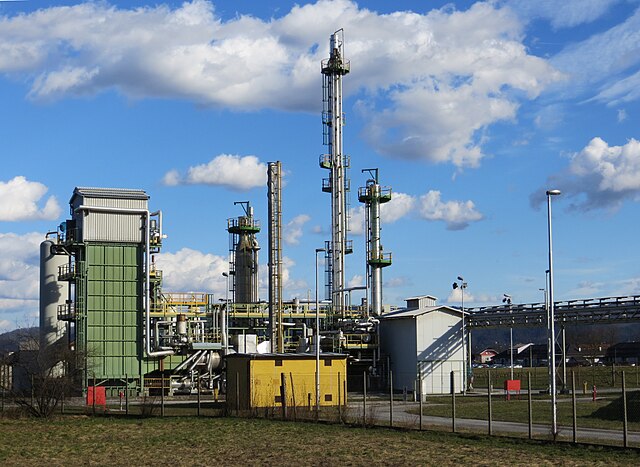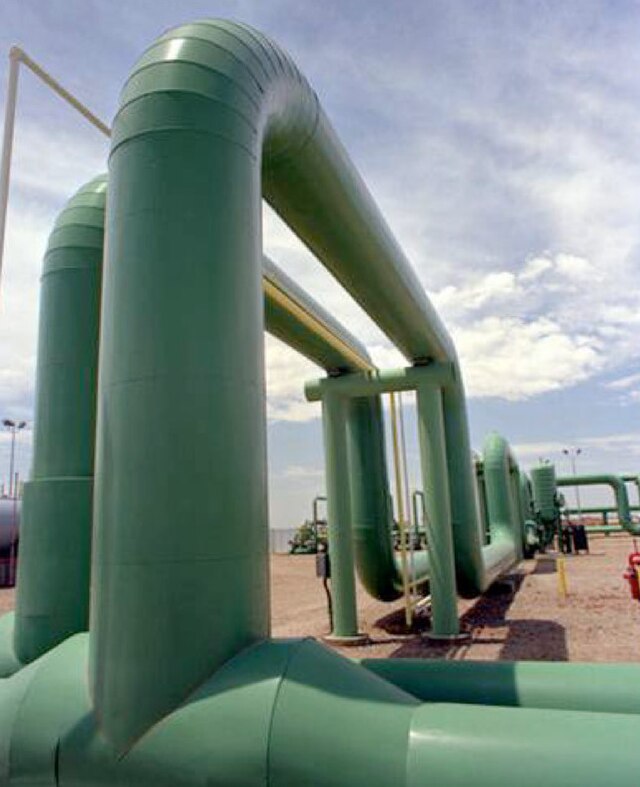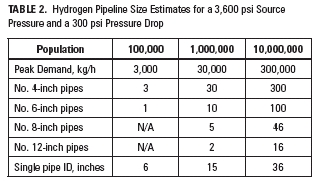Loading AI tools
From Wikipedia, the free encyclopedia
A hydrogen infrastructure is the infrastructure of hydrogen pipeline transport, points of hydrogen production and hydrogen stations for distribution as well as the sale of hydrogen fuel,[1] and thus a crucial prerequisite before a successful commercialization of fuel cell technology.[2]


The hydrogen infrastructure would consist mainly of industrial hydrogen pipeline transport and hydrogen-equipped filling stations. Hydrogen stations which were not situated near a hydrogen pipeline would get supply via hydrogen tanks, compressed hydrogen tube trailers, liquid hydrogen trailers, liquid hydrogen tank trucks or dedicated onsite production.
Pipelines are the cheapest way to move hydrogen over long distances compared to other options. Hydrogen gas piping is routine in large oil-refineries, because hydrogen is used to hydrocrack fuels from crude oil. The IEA recommends existing industrial ports be used for production and existing natural gas pipelines for transport: also international co-operation and shipping.[3]
South Korea and Japan,[4] which as of 2019 lack international electrical interconnectors, are investing in the hydrogen economy.[5] In March 2020, the Fukushima Hydrogen Energy Research Field was opened in Japan, claiming to be the world's largest hydrogen production facility.[6] Much of the site is occupied by a solar array; power from the grid is also used for electrolysis of water to produce hydrogen fuel.[7]
A hydrogen highway is a chain of hydrogen-equipped filling stations and other infrastructure along a road or highway which allow hydrogen vehicles to travel.
Hydrogen stations which are not situated near a hydrogen pipeline get supply via hydrogen tanks, compressed hydrogen tube trailers, liquid hydrogen trailers, liquid hydrogen tank trucks or dedicated onsite production. Some firms as ITM Power are also providing solutions to make your own hydrogen (for use in the car) at home.[8] Government supported activities to expand an hydrogen fuel infrastructure are ongoing in the US state of California, in some member states of the European Union (most notably in Germany[2]) and in particular in Japan.
Hydrogen pipeline transport is a transportation of hydrogen through a pipe as part of the hydrogen infrastructure. Hydrogen pipeline transport is used to connect the point of hydrogen production or delivery of hydrogen with the point of demand, pipeline transport costs are similar to CNG,[9] the technology is proven,[10] however most hydrogen is produced on the place of demand with every 50 to 100 miles (80 to 161 km) an industrial production facility.[11] As of 2004[update], there are 900 miles (1,448 km) of low pressure hydrogen pipelines in the US and 930 miles (1,497 km) in Europe.
According to a 2024 research report, the United States has 1,600 miles (2,570 kilometers) of hydrogen pipelines; the global total stands at 2,800 miles (4,500 kilometers).[12] The World Economic Forum, in December 2023, estimated that Europe had approximately 1,600 kilometers of hydrogen pipelines.[13]
Hydrogen embrittlement (a reduction in the ductility of a metal due to absorbed hydrogen) is not a problem for hydrogen gas pipelines. Hydrogen embrittlement only happens with 'diffusible' hydrogen, i.e. atoms or ions. Hydrogen gas, however, is molecular (H2), and there is a very significant energy barrier to splitting it into atoms.[14]
The National Renewable Energy Laboratory believes that US counties have the potential to produce more renewable hydrogen for fuel cell vehicles than the gasoline they consumed in 2002.[15]
As an energy buffer, hydrogen produced via water electrolysis and in combination with underground hydrogen storage or other large-scale storage technologies, could play an important role for the introduction of fluctuating renewable energy sources like wind or solar power.[2]
98% of hydrogen production uses the steam reforming method.[16] Methods such as electrolysis of water are also used.[17] The world's largest facility for producing electrolytic hydrogen fuel is claimed[18] to be the Fukushima Hydrogen Energy Research Field (FH2R), a 10MW-class hydrogen production unit, inaugurated on 7 March 2020, in Namie, Fukushima Prefecture.[19] The site occupies 180,000 square meters of land, much of which is occupied by a solar array; but power from the grid is also used to conduct electrolysis of water to produce hydrogen fuel.[18]
Hydrogen pipeline transport is a transportation of hydrogen through a pipe as part of the hydrogen infrastructure.

Hydrogen pipeline transport is used to transport hydrogen from the point of production or delivery to the point of demand. Although hydrogen pipeline transport is technologically mature,[24][25] and the transport costs are similar to those of CNG,[26] most hydrogen is produced in the place of demand, with an industrial production facility every 50 to 100 miles (80 to 161 km)[27]
For process metal piping at pressures up to 7,000 psi (48 MPa), high-purity stainless steel piping with a maximum hardness of 80 HRB is preferred.[28] This is because higher hardnesses are associated with lower fracture toughness so stronger, higher hardness steel is less safe.
Composite pipes are assessed like:
Fiber-Reinforced Polymer pipelines (or FRP pipeline) and reinforced thermoplastic pipes are researched.[29][30][31][32]
Carrying hydrogen in steel pipelines (grades: API5L-X42 and X52; up to 1,000psi/7,000kPa, constant pressure/low pressure cycling) does not lead to hydrogen embrittlement.[33] Hydrogen is typically stored in steel cylinders without problems. Coal gas (also known as town gas) is 50% hydrogen and was carried in cast-iron pipes for half a century without any embrittlement issues.

A hydrogen highway is a chain of hydrogen-equipped public filling stations, along a road or highway, that allows hydrogen powered cars to travel.[34] William Clay Ford Jr. has stated that infrastructure is one of three factors (also including costs and manufacturability in high volumes) that hold back the marketability of fuel cell cars.
Hydrogen fueling stations generally receive deliveries of hydrogen by tanker truck from hydrogen suppliers.[35] An interruption at a hydrogen supply facility can shut down multiple hydrogen fueling stations.[36] A hydrogen fueling station costs between $1 million and $4 million to build.[37]
As of 2019, 98% of hydrogen is produced by steam methane reforming, which emits carbon dioxide.[16] The bulk of hydrogen is also transported in trucks, so pollution is emitted in its transportation.[35]

A hydrogen station is a storage or filling station for hydrogen fuel.[38] The hydrogen is dispensed by weight.[39][40] There are two filling pressures in common use: H70 or 700 bar, and the older standard H35 or 350 bar.[41] As of 2021[update], around 550 filling stations were available worldwide.[41] According to H2stations.org by Ludwig-Bölkow-Systemtechnik (LBST), as of the end of 2023, there were 921 hydrogen refueling stations globally,[42] although this number clearly conflicts with those published by AFDC.[43] The distribution of these stations is highly uneven, with a concentration in East Asia, particularly in China, Japan and South Korea; Central Europe and California in the United States. Other regions have very few, if any, hydrogen refuelling stations.[42][43]
Hydrogen fueling stations can be divided into off-site stations, where hydrogen is delivered by truck or pipeline, and on-site stations that produce and compress hydrogen for the vehicles.[44][45]
Home hydrogen fueling stations are available to consumers.[46] A model that can produce 12 kilograms of hydrogen per day sells for $325,000.[47]
Solar powered water electrolysing hydrogen home stations are composed of solar cells, power converter, water purifier, electrolyzer, piping, hydrogen purifier,[48] oxygen purifier, compressor,[49] pressure vessels[50] and a hydrogen outlet.[51]
Hydrogen fuel is hazardous because of its low ignition energy, high combustion energy, and because it easily leaks from tanks.[52] Explosions at hydrogen filling stations have been reported.[53]
Hydrogen fuelling stations generally receive deliveries by truck from hydrogen suppliers. An interruption at a hydrogen supply facility can shut down multiple hydrogen fuelling stations due to an interruption of the supply of hydrogen.[54]
There are far fewer Hydrogen filling stations than gasoline fuel stations, which in the US alone numbered 168,000 in 2004.[55] Replacing the US gasoline infrastructure with hydrogen fuel infrastructure is estimated to cost a half trillion U.S. dollars.[56] A hydrogen fueling station costs between $1 million and $4 million to build.[57] In comparison, battery electric vehicles can charge at home or at public chargers. As of 2023, there are more than 60,000 public charging stations in the United States, with more than 160,000 outlets.[43] A public Level 2 charger, which comprise the majority of public chargers in the US, costs about $2,000, and DC fast chargers, of which there are more than 30,000 in the U.S.,[43] generally cost between $100,000 and $250,000,[58] although Tesla superchargers are estimated to cost approximately $43,000.[59]
During refueling, the flow of cold hydrogen can cause frost to form on the dispenser nozzle, sometimes leading to the nozzle becoming frozen to the vehicle being refueled.[60]
Consulting firm Ludwig-Bölkow-Systemtechnik tracks global hydrogen filling stations and publishes a map.[61]
In 2019, there were 178 publicly available hydrogen fuel stations in operation.[62]

As of May 2023[update], there are 167 publicly available hydrogen fuel stations in operation in Japan.[63][64] In 2012 there were 17 hydrogen stations,[65] and in 2021, there were 137 publicly available hydrogen fuel stations in Japan.[41]
By the end of 2023, China had built 354 hydrogen refueling stations.[66]
In 2019, there were 33 publicly available hydrogen fuel stations in operation in South Korea.[62][67] In November 2023, however, due to hydrogen supply problems and broken stations, most fueling stations in South Korea offered no hydrogen.[68] 41 out of the 159 hydrogen stations in the country were listed as open, and some of these were rationing supplies of hydrogen.[69]
In 2019, there were 177 stations in Europe.[62][70][71] According to H2stations.org by Ludwig-Bölkow-Systemtechnik (LBST), there were 265 hydrogen refuelling stations in Europe by the end of 2023.[42]
As of June 2023,[update] there were 105 hydrogen fuel stations in Germany,[42] As of June 2023,[update] there were 5 publicly available hydrogen fuel stations in France,[70] 3 publicly available hydrogen fuel stations in Iceland,[70] one publicly available hydrogen fuel station in Italy,[70] 4 publicly available hydrogen fuel stations in The Netherlands,[70] 2 publicly available hydrogen fuel stations in Belgium,[70] 4 publicly available hydrogen fuel stations in Sweden,[70] 3 publicly available hydrogen fuel stations in Switzerland[70] and 6 publicly available hydrogen fuel stations in Denmark.[70] Everfuel, the only operator of hydrogen stations in Denmark, announced in 2023 the closure of all of its public hydrogen stations in the country.[72][73]
As of June 2021,[update] there were 2 publicly available hydrogen fuel stations in Norway, both in the Oslo area.[74] Since the explosion at the hydrogen filling station in Sandvika in June 2019, the sale of hydrogen cars in Norway has halted.[75] In 2023, Everfuel announced the closure of its two public hydrogen stations in Norway and cancelled the opening of a third.[72] In 2024 Shell discontinued its hydrogen fuel projects in Norway.[76]
As of June 2020,[update] there were 11 publicly available hydrogen fuel stations in the United Kingdom,[70] but as of 2023, the number decreased to 5.[77] In 2022, Shell closed its three hydrogen stations in the UK,[78]
As of July 2023, there were 10 fueling stations in Canada, 9 of which were open to the public:
As of July 2024[update], there were 54 publicly accessible hydrogen refueling stations in the US, 53 of which were located in California, with one in Hawaii.[43]
In 2021, the first Australian publicly available hydrogen fuel station opened in Canberra, operated by ActewAGL.[88]

A hydrogen tank (other names- cartridge or canister) is used for hydrogen storage.[89][90][91] The first type IV hydrogen tanks for compressed hydrogen at 700 bars (70 MPa; 10,000 psi) were demonstrated in 2001, the first fuel cell vehicles on the road with type IV tanks are the Toyota FCHV, Mercedes-Benz F-Cell and the GM HydroGen4.
Various applications have allowed the development of different H2 storage scenarios. Recently, the Hy-Can[92] consortium has introduced a small one liter, 10 bars (1.0 MPa; 150 psi) format. Horizon Fuel Cells is now selling a refillable 3 megapascals (30 bar; 440 psi) metal hydride form factor for consumer use called HydroStik.[93]

In accordance with ISO/TS 15869 (revised):
This specification was replaced by ISO 13985:2006 and only applies to liquid hydrogen tanks.
Actual Standard EC 79/2009
Using magnesium[100] for hydrogen storage, a safe but weighty reversible storage technology. Typically the pressure requirement are limited to 10 bars (1.0 MPa; 150 psi). The charging process generates heat whereas the discharge process will require some heat to release the H2 contained in the storage material. To activate these types of hydrides, at the current state of development you need to reach approximately 300 °C (572 °F). [101] [102] [103]
See also sodium aluminium hydride
Seamless Wikipedia browsing. On steroids.
Every time you click a link to Wikipedia, Wiktionary or Wikiquote in your browser's search results, it will show the modern Wikiwand interface.
Wikiwand extension is a five stars, simple, with minimum permission required to keep your browsing private, safe and transparent.